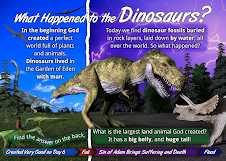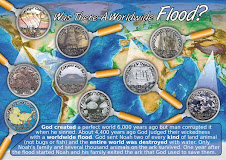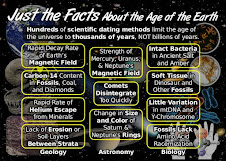The article will give you an idea of what happened during the global catastrophe of the Biblical Flood. While this article assumes long ages, if you read with discernment it is evident that the dinosaurs and sediment that buried them were part of Noah's Flood. Read on...
Somewhere south of Newcastle, amid the wide-open prairie and rolling
hills, rests a mass grave. A femur here. A tooth there. A tip of a tail
barely poking through the ground somewhere else.
The cause of death is unknown. It could have been a lightning strike, disease or an attack by a band of marauding T. rexes.
The victims: At least four U-Haul-sized, plant-eating triceratopses.
Paleontologists worked for two months this summer and found 250 bones. Only 950 more to go.
On a hot day in mid-August, one paleontologist held up a pterygoid
for inspection. A pterygoid is a portion of a triceratops palette in its
skull. It's roughly the size of a loaf of bread, and had never
previously been found complete and alone.
Some portions measure only a single millimeter thick. Removing it
from the earth was a painstaking task. The ground was hard and the bone
weak.
"There are maybe 10 people in the world who care about this bone,"
said Matt Larson, a paleontologist for the Black Hills Institute of
Geologic Research.
"And four are here."
What it represents is entirely different. That pterygoid could belong
to the most complete triceratops skeleton ever found — something many
more people care about.
The institute's research team is unearthing what is, at minimum, four
triceratops skeletons. Scientists believe the collection could be the
key to answering how one of the prehistoric world's unique vegetarians
lived and died.
Amazing Design in the Chemistry of Pregnancy
by Brian Thomas, M.S. *
The onset of pregnancy presents an apparent contradiction. Ovulating and initially pregnant mothers experience an increase in progesterone. On the one hand, this hormone signals the immune system to back down and lay low. That's critical, because otherwise her body would fight and kill sperm cells as though they were unwelcome invaders, and she would never become pregnant.But on the other hand, progesterone reduces cholesterol levels in her body. Too much progesterone would doom a developing baby, who requires cholesterol. Why would one action both promote and prevent a single outcome? Two University of California evolutionary biologists believe they have decoded the answer.
Publishing in the June 2013 issue of The Quarterly Review of Biology, the authors first noted that many infections, caused by both viruses and bacteria, either depend on or are enhanced by cholesterol-containing "lipid rafts" embedded on cell membranes.1 The invaders link to the lipids, using them as doors to access and infect cells, causing disease.
Normally, a woman's immune system provides plenty of protection from such potential pathogens, ...
* Mr. Thomas is Science Writer at the Institute for Creation Research.
Article posted on August 12, 2013.








